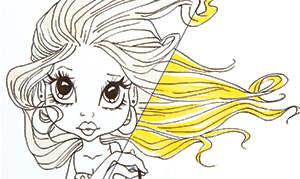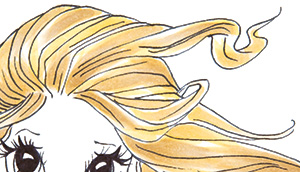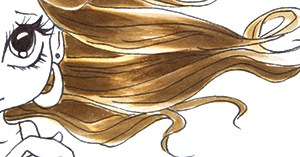
Use Copic Markers to Make Coloring Hair Easy and Realistic!
By Colleen Schaan
Short, long, blond, black, straight, curly, thick, thin-no matter the style, shape or shade, hair is considered our crowning glory. Create your own gloriously colored hair using the following techniques.
While there are different approaches to coloring hair and many theories about what is "right," there are some basic guidelines that will help you create fabulous and realistic tresses.
With the exception of the base layer, always use a flicking motion to apply ink to the hair. This will help create texture.
Make the entire flick in one smooth movement-don't "sketch" them together.
Always color in the direction of the hair growth. Flick from the crown down and the tips up.
Shiny hair has lots of contrast-keep those highlights light but keep in mind that realistic hair does not have white highlights.
Texture is good! Let each layer of ink dry a bit before adding the next to keep the ink from blending.
Reveal separate sections of hair by leaving the edges of some sections light.
*Images used for tutorials are: CaliGirl, Fancy and LaLa from Saturated Canary.
Right now, many of the popular people images have long, flowing locks that can be a bit intimidating to color. Don't stress the tresses! Follow these simple steps to lovely locks.
Step 1: Base the entire hair area with the light base color (E40). Do not leave any white areas (Photo 1).

Step 2: Flick undertone color (Y21) over most of the hair area. Leave highlights and areas at the edges of each section light (Photo 2).

Step 3: Add flicks of the lightest hair color (E42) over
the same areas as the undertone color (Photo 3).

Step 4: Darken sections of hair by flicking the medium color (E43) from the crown down and the tips up. Remember to leave the edges of each section light. Do not blend (Photo 4).

Step 5: Add darkest color (E44) to hair. Flick from the crown down and the tips up. Leave the edges of each section light. Do not blend.
Step 6: (Optional) Add more contrast to the highlights by gently going over the highlight areas with the undertone color (Y21). Do not blend (Photo 6).
Step 7: Continue coloring the rest of the image as normal.
Many other hairstyles are colored using the same techniques. On this fancy updo, notice how the areas near the crown and closest to the ribbon tie are dark? Think of these areas as another "crown or tip" area. Make sure to leave the edges of the sections light to help differentiate them. This image was colored with YR31, E97, E99 and E09.
Not all hair is straight. Some hair has riotous waves while other hair has tight curls. Creating the look of curly hair is just as easy (if not easier) than soft flowing waves. Remember that hair has texture and the stroke marks show that texture. To create curly texture, use a scribbling motion for looser curls and a dotting motion for tiny tight curls. This image was colored with E31, E44, E17, E27 and E79.
Whatever the style, texture or color, top off your next image with 4 a glorious head of hair!
This Copic tutorial was first published in the Spring 2013 issue of CardMaker magazine. To get more information on Copic marker techniques:
- Purchase a copy of Colleen's book Copic Coloring Guide.
- Check out Colleen's blog, www.distinctivetouches.com.
- Subscribe to CardMaker magazine, where Colleen has a regular column featuring Copic marker techniques.


